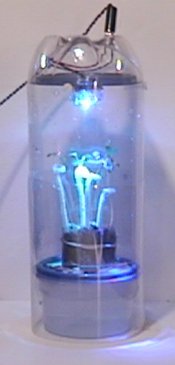
This particular experiment has been in my to do file for over five years. Over the years I expected someone, presumably NASA, to hit upon the same idea, perform the experiment, and publish the results. This did not happen and it leaves us with a wonderfully simple experiment that has the potential of impacting upon human space travel in the future.
This experiment grew out of thoughts of minimizing the power requirements for life support on extended manned space travel to Mars and the other planets. Its been realized for some time that for extended space flight, food and oxygen would need to be grown and recycled. Plants provide food while recycling the byproduct of animal respiration, carbon dioxide, back into breathable oxygen. In addition plants help purify wastewater back into potable drinking water. Nothing much new here, but lets continue stating the obvious for a little while longer (its background).
Power generators take up precious space and weight on board the spacecraft. The more power needed for the life support the greater the space and weight requirements of the power generation equipment. Anything that can reduce power consumption will improve the overall mission profile.
This experiment illustrates a possible method of reducing the power needed to grow plants onboard spacecraft. The hypothesis is based on the idea that a plant's photosynthesis cycle may not require continuous light, (100% on) to achieve optimum growth. If this is hypothesis is correct, it becomes reasonable to assume that a strobe light, (a light which turns on and off rapidly) may be used to grow plants effectively while saving electrical power.
This experiment is designed to test this hypothesis. In the experiment, the duty cycle of the light is 50% with a frequency of approximately 3 Hz. The plants grown under the 3Hz strobe light are only using 50% of the electrical energy for light as used by the control.
Next Page (Intensity vs. Duration)

